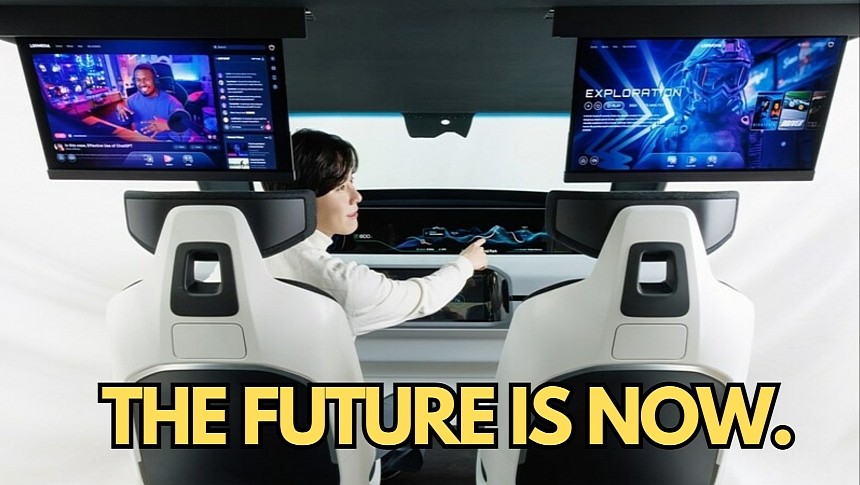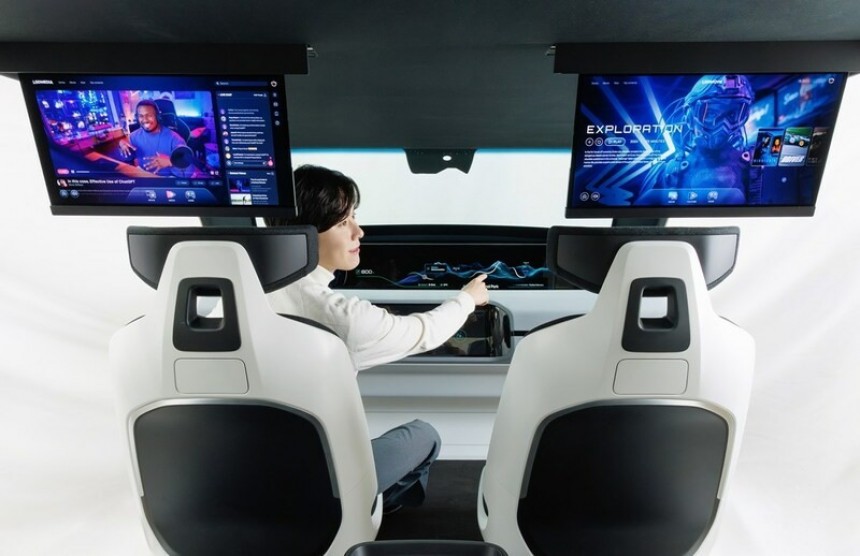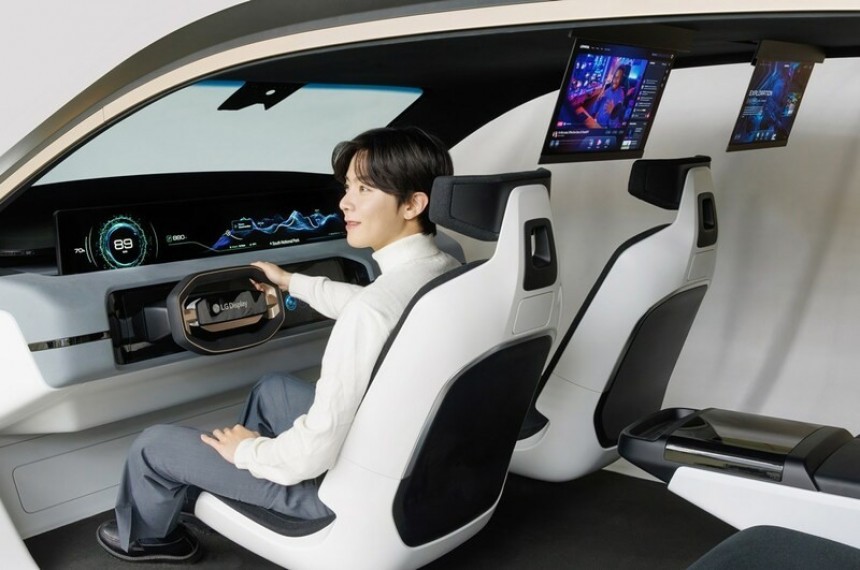Carmakers have seemingly entered a competition for fitting their cars with larger and larger displays, giving up on buttons and turning everything into a screen.
Tesla's massive tablet set a new standard in the automotive business, and now other companies are trying to follow in its footsteps with similar approaches typically based on portrait displays.
However, the more tech companies expand into the automotive field, the more obvious it becomes that the future won't come down to having a screen on the dashboard but turning the dashboard itself into a screen.
LG attended this year's CES in Las Vegas with a concept that demonstrates how the whole thing would work. It's not the first time we've seen a concept envisioning a screen taking over the dashboard, but LG's idea uses the company's advanced technologies to offer a set of features that few would be able to develop.
It all starts with the dashboard, which no longer uses a classic design but an all-screen construction. It's made entirely of a display, starting from the driver's side and extending to the front passenger. You won't get any buttons, and you don't even need them, as the gigantic display will let you do anything with taps on the screen.
LG explains that such a large display wouldn't work without the ultra-high-resolution P-OLED, which sports a flexible plastic substrate. The main benefit is that the display would be light and flexible, fitting an automotive use like a glove.
The company says the dashboard screen integrates its Advanced Thin OLED (ATO) technology, which relies on glass substrates, making the dashboard screen as thin as possible. And last but not least, LG turned to LTPS (Low-Temperature Polycrystalline Silicon) LCD for the main panel, allowing for larger and higher resolutions.
Put all these technologies under the same roof, and you get a next-generation car dashboard ready to do anything from providing access to vehicle functions to playing multimedia content at high resolutions.
I know what you're thinking. Playing multimedia content shouldn't be allowed on the dashboard, and considering the large screen estate, it'd be a shame to block the front passenger from enjoying a good TV show or a Netflix movie while traveling. LG has found a clever solution to this problem, and it all comes down to the Switchable Privacy Mode, or SPM.
If you're a tech-savvy person, you probably know where this is going. With SPM, the dashboard adjusts the display's viewing angle, so the driver can't see what's on the screen. It means the driver can focus on the road without being distracted by the movie or the game running on the display.
LG's passion for displays also expands to the rear seats, where the company uses some of its latest-generation technologies specifically to provide the occupants traveling in the back with similar content. People sitting in the rear seats can also watch movies, play games, or enjoy any other high-resolution content on the screen using various approaches that will allow them to adjust the screen estate.
If you wonder how this is possible, LG says it'll use slideable and foldable OLED panels for the rear seats. It means the displays can be hidden away or extended as the rear passengers wish. Do you want to watch the news but not let the display get in the way and still see what's happening on the road? You can use the smallest screen estate by folding the unnecessary panels. Do you want to watch a movie and turn the viewing experience into a cinema on wheels? Unfold all screens and convert the rear infotainment screen into a larger panel with impressive resolution.
Everything will be fully customizable and given LG is one of the leaders in display technology, the screen quality, resolution, and viewing experience will be top-notch regardless of the chosen configuration.
The driver is the only one left out of this extreme fun. While the dashboard turning into a screen makes the driving experience feel more modern, the driver's only interaction with what happens on the screen comes down to vehicle information and functions. Everybody else can truly experience the power of high-end displays, though I believe LG could also allow the driver to watch videos and play games when the car is not in motion.
For example, if the vehicle is connected to a charger, the driver can turn the dashboard screen into a gaming monitor or watch a Netflix show until the battery is charged. When the vehicle starts moving, the system can restrict the use of the screen, automatically returning to the default configuration focused on vehicle information and functions.
LG's brilliant idea is still in the concept stage, with the company promising to demonstrate various versions at CES. It'll take years until we'll see it in a production vehicle, but there's no doubt it'll happen sooner or later. However, as anyone can imagine, all these technologies won't come cheaply.
However, the more tech companies expand into the automotive field, the more obvious it becomes that the future won't come down to having a screen on the dashboard but turning the dashboard itself into a screen.
LG attended this year's CES in Las Vegas with a concept that demonstrates how the whole thing would work. It's not the first time we've seen a concept envisioning a screen taking over the dashboard, but LG's idea uses the company's advanced technologies to offer a set of features that few would be able to develop.
It all starts with the dashboard, which no longer uses a classic design but an all-screen construction. It's made entirely of a display, starting from the driver's side and extending to the front passenger. You won't get any buttons, and you don't even need them, as the gigantic display will let you do anything with taps on the screen.
LG explains that such a large display wouldn't work without the ultra-high-resolution P-OLED, which sports a flexible plastic substrate. The main benefit is that the display would be light and flexible, fitting an automotive use like a glove.
Put all these technologies under the same roof, and you get a next-generation car dashboard ready to do anything from providing access to vehicle functions to playing multimedia content at high resolutions.
I know what you're thinking. Playing multimedia content shouldn't be allowed on the dashboard, and considering the large screen estate, it'd be a shame to block the front passenger from enjoying a good TV show or a Netflix movie while traveling. LG has found a clever solution to this problem, and it all comes down to the Switchable Privacy Mode, or SPM.
If you're a tech-savvy person, you probably know where this is going. With SPM, the dashboard adjusts the display's viewing angle, so the driver can't see what's on the screen. It means the driver can focus on the road without being distracted by the movie or the game running on the display.
LG's passion for displays also expands to the rear seats, where the company uses some of its latest-generation technologies specifically to provide the occupants traveling in the back with similar content. People sitting in the rear seats can also watch movies, play games, or enjoy any other high-resolution content on the screen using various approaches that will allow them to adjust the screen estate.
Everything will be fully customizable and given LG is one of the leaders in display technology, the screen quality, resolution, and viewing experience will be top-notch regardless of the chosen configuration.
The driver is the only one left out of this extreme fun. While the dashboard turning into a screen makes the driving experience feel more modern, the driver's only interaction with what happens on the screen comes down to vehicle information and functions. Everybody else can truly experience the power of high-end displays, though I believe LG could also allow the driver to watch videos and play games when the car is not in motion.
For example, if the vehicle is connected to a charger, the driver can turn the dashboard screen into a gaming monitor or watch a Netflix show until the battery is charged. When the vehicle starts moving, the system can restrict the use of the screen, automatically returning to the default configuration focused on vehicle information and functions.
LG's brilliant idea is still in the concept stage, with the company promising to demonstrate various versions at CES. It'll take years until we'll see it in a production vehicle, but there's no doubt it'll happen sooner or later. However, as anyone can imagine, all these technologies won't come cheaply.










